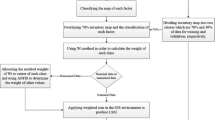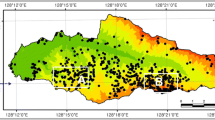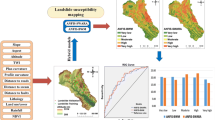Abstract
The aim of landslide susceptibility mapping (LSM) is to produce the most important and basic information required for overall landslide disaster planning and mitigation. Different statistical bivariate methods such as frequency ratio (FR) and weights-of-evidence (WOE) have been widely used for LSM. Although results of these aforementioned statistical methods are generally acceptable, however, they can be improved further by fine tuning the conditioning factor’s classes. The purpose of this paper is to overcome some drawbacks of the bivariate models by developing a novel hybrid method using adaptive neuro-fuzzy inference system (ANFIS) and statistical bivariate methods (FR and WOE) in geographical information system. The provinces of southern Zagros Mountains (Iran) are chosen as a case study to implement the proposed method. First, landslide inventory map was produced using various data source such as historical landslides locations, remote sensing images and land surveying techniques. Second, the inventory data were divided into a ratio 70:30 for training and testing the models. Third, twelve landslide conditioning and triggering factors (such as altitude, slope, aspect, plan and profile curvatures, distance to roads, distance to streams, distance to faults, rainfall, seismicity, land use and lithology) were selected and categorized in two groups consisting of numerical and nominal values. Then, each conditioning factor was classified and the weight of each class was determined by using FR and WOE models. The outputs of individual statistical and hybrid methods were applied to determine nominal and continuous numerical data, respectively. In the hybrid approach, the calculated weights of each class were allocated to the center of each class, and the rest of the weights were determined by ANFIS. Landslide locations which were not used in training the models were used for validation. The produced susceptibility maps were validated and compared using area under the curve (AUC). Results indicated that predictive performances of hybrid models (FR-ANFIS and WOE-ANFIS) have better performance than the statistical models (FR and WOE). The AUCs of success rates are 85, 86, 87 and 87% and the AUCs of predicted rates are 82, 82, 85 and 84% for FR, WOE, FR-ANFIS, and WOE-ANFIS, respectively. Additionally, frequency ratio plots (FRP) and seed cells area index SCAI methods were also employed for a second round of validation. The FRP and SCAI graphs illustrated higher performance for the hybrid LSM models. The proposed approach can be applied in other types of natural hazard modeling such as flood, land subsidence, and gully erosion.












Similar content being viewed by others
References
Aleotti P, Chowdhury R (1999) Landslide hazard assessment: summary review and new perspectives. Bull Eng Geol Environ 58:21–44
Althuwaynee OF, Pradhan B, Lee S (2012) Application of an evidential belief function model in landslide susceptibility mapping. Comput Geosci 44:120–135
Ayalew L, Yamagishi H (2005) The application of GIS-based logistic regression for landslide susceptibility mapping in the Kakuda-Yahiko mountains central Japan. Geomorphology 65:15–31
Ayalew L, Yamagishi H, Marui H, Kanno T (2005) Landslides in Sado Island of Japan: part II GIS-based susceptibility mapping with comparisons of results from two methods and verifications. Eng Geol 81:432–445
Bai S, Wang J, Zhang Z, Cheng C (2012) Combined landslide susceptibility mapping after Wenchuan earthquake at the Zhouqu segment in the Bailongjiang Basin China. Catena 99:18–25
Bednarik M, Magulová B, Matys M, Marschalko M (2010) Landslide susceptibility assessment of the Kraľovany–Liptovský Mikuláš railway case study. Phys Chem Earth Parts A/B/C 35:162–171
Bolstad P (2005) GIS fundamentals: a first text on geographic information systems. Eider Press, White Bear Lake
Bonham-Carter GF (1994) Geographic information systems for geoscientists-modeling with GIS. Comput Methods Geosci 13:398
Bui DT, Pradhan B, Lofman O, Revhaug I, Dick OB (2012) Landslide susceptibility assessment in the Hoa Binh province of Vietnam: a comparison of the Levenberg–Marquardt and Bayesian regularized neural networks. Geomorphology 171:12–29
Burrough PA (1986) Principles of geographical information systems for land resources assessment. Clarendon Press, Oxford [Oxfordshire], p 220
Che VB et al (2012) Landslide susceptibility assessment in Limbe (SW Cameroon): a field calibrated seed cell and information value method. Catena 92:83–98
Choi J, Oh H-J, Lee H-J, Lee C, Lee S (2012) Combining landslide susceptibility maps obtained from frequency ratio, logistic regression, and artificial neural network models using ASTER images and GIS. Eng Geol 124:12–23. doi:10.1016/j.enggeo.2011.09.011
Conforti M, Pascale S, Robustelli G, Sdao F (2014) Evaluation of prediction capability of the artificial neural networks for mapping landslide susceptibility in the Turbolo River catchment (northern Calabria, Italy). Catena 113:236–250
Dahal RK, Hasegawa S, Nonomura A, Yamanaka M, Dhakal S, Paudyal P (2008) Predictive modelling of rainfall-induced landslide hazard in the Lesser Himalaya of Nepal based on weights-of-evidence. Geomorphology 102:496–510
Dai F, Lee C, Ngai YY (2002) Landslide risk assessment and management: an overview. Eng Geol 64:65–87
De Blasio FV (2011) Introduction to the physics of landslides: lecture notes on the dynamics of mass wasting. Springer Science and Business Media, Berlin
Dehnavi A, Aghdam IN, Pradhan B, Morshed Varzandeh MH (2015a) A new hybrid model using step-wise weight assessment ratio analysis (SWARA) technique and adaptive neuro-fuzzy inference system (ANFIS) for regional landslide hazard assessment in Iran. Catena 135:122–148. doi:10.1016/j.catena.2015.07.020
Dehnavi A, Aghdam IN, Pradhan B, Varzandeh MHM (2015b) A new hybrid model using step-wise weight assessment ratio analysis (SWARA) technique and adaptive neuro-fuzzy inference system (ANFIS) for regional landslide hazard assessment in Iran. Catena 135:122–148
Devkota KC et al (2013) Landslide susceptibility mapping using certainty factor, index of entropy and logistic regression models in GIS and their comparison at Mugling–Narayanghat road section in Nepal Himalaya. Nat Hazards 65:135–165
El-Shafie A, Taha MR, Noureldin A (2007) A neuro-fuzzy model for inflow forecasting of the Nile river at Aswan high dam. Water Resour Manag 21:533–556
Feizizadeh B, Blaschke T (2013) GIS-multicriteria decision analysis for landslide susceptibility mapping: comparing three methods for the Urmia lake basin, Iran. Nat Hazards 65:2105–2128
Fell R, Corominas J, Bonnard C, Cascini L, Leroi E, Savage WZ (2008) Guidelines for landslide susceptibility, hazard and risk zoning for land use planning. Eng Geol 102:85–98
Florsheim JL, Nichols A (2013) Landslide area probability density function statistics to assess historical landslide magnitude and frequency in coastal California. Catena 109:129–138. doi:10.1016/j.catena.2013.04.005
Ghorbani M (2013) The economic geology of Iran: mineral deposits and natural resources. Springer Science and Business Media, Berlin
Guzzetti F, Carrara A, Cardinali M, Reichenbach P (1999) Landslide hazard evaluation: a review of current techniques and their application in a multi-scale study Central Italy. Geomorphology 31:181–216
Jang J-SR, Sun C-T, Mizutani E (1997) Neuro-fuzzy and soft computing-a computational approach to learning and machine intelligence [Book Review]. In: IEEE Transactions on automatic control, 42:1482--1484
Jebur MN, Pradhan B, Tehrany MS (2014) Optimization of landslide conditioning factors using very high-resolution airborne laser scanning (LiDAR) data at catchment scale. Remote Sens Environ 152:150–165
Jiménez-Perálvarez J, Irigaray C, El Hamdouni R, Chacón J (2011) Landslide-susceptibility mapping in a semi-arid mountain environment: an example from the southern slopes of Sierra Nevada (Granada, Spain). Bull Eng Geol Environ 70:265–277
Kavzoglu T, Sahin EK, Colkesen I (2013) Landslide susceptibility mapping using GIS-based multi-criteria decision analysis, support vector machines, and logistic regression. Landslides 11:425–439. doi:10.1007/s10346-013-0391-7
Keskin ME, Taylan D, Terzi O (2006) Adaptive neural-based fuzzy inference system (ANFIS) approach for modelling hydrological time series. Hydrol Sci J 51:588–598
Klir G, Yuan B (1995) Fuzzy sets and fuzzy logic, vol 4. Prentice Hall, Upper Saddle River
Kumanan S, Jesuthanam C, Kumar RA (2008) Application of multiple regression and adaptive neuro fuzzy inference system for the prediction of surface roughness. Int J Adv Manuf Technol 35:778–788
Lee S, Pradhan B (2006) Landslide hazard mapping at Selangor Malaysia using frequency ratio and logistic regression models. Landslides 4:33–41. doi:10.1007/s10346-006-0047-y
Lee S, Ryu J-H, Won J-S, Park H-J (2004) Determination and application of the weights for landslide susceptibility mapping using an artificial neural network. Eng Geol 71:289–302
Lee S, Kim YS, Oh HJ (2012) Application of a weights-of-evidence method and GIS to regional groundwater productivity potential mapping. J Environ Manag 96:91–105. doi:10.1016/j.jenvman.2011.09.016
Liu JP, Zeng ZP, Liu HQ, Wang HB (2011) A rough set approach to analyze factors affecting landslide incidence. Comput Geosci 37:1311–1317. doi:10.1016/j.cageo.2011.02.010
Morshed Varzandeh MH, Rahbari O, Vafaeipour M, Raahemifar K, Heidarzadeh F (2014) Performance of neural wavelet and ANFIS algorithms for short-term prediction of solar radiation and wind velocities. In: The 4th world sustainability forum, multidisciplinary digital publishing institute, Basel
Mostafi A (1970) Climatic atlas of Iran. University of Tehran, Iran
Nadim F, Kjekstad O, Peduzzi P, Herold C, Jaedicke C (2006) Global landslide and avalanche hotspots. Landslides 3:159–173
Nandi A, Shakoor A (2010) A GIS-based landslide susceptibility evaluation using bivariate and multivariate statistical analyses. Eng Geol 110:11–20. doi:10.1016/j.enggeo.2009.10.001
Neaupane KM, Piantanakulchai M (2006) Analytic network process model for landslide hazard zonation. Eng Geol 85:281–294
Nourani V, Pradhan B, Ghaffari H, Sharifi SS (2013) Landslide susceptibility mapping at Zonouz plain, Iran using genetic programming and comparison with frequency ratio, logistic regression, and artificial neural network models. Nat Hazards 71:523–547. doi:10.1007/s11069-013-0932-3
Oh H-J, Pradhan B (2011) Application of a neuro-fuzzy model to landslide-susceptibility mapping for shallow landslides in a tropical hilly area. Comput Geosci 37:1264–1276
Ozdemir A, Altural T (2013) A comparative study of frequency ratio, weights of evidence and logistic regression methods for landslide susceptibility mapping: sultan mountains, SW Turkey. J Asian Earth Sci 64:180–197. doi:10.1016/j.jseaes.2012.12.014
Pourghasemi HR, Mohammady M, Pradhan B (2012a) Landslide susceptibility mapping using index of entropy and conditional probability models in GIS: safarood basin, Iran. Catena 97:71–84. doi:10.1016/j.catena.2012.05.005
Pourghasemi HR, Pradhan B, Gokceoglu C (2012b) Application of fuzzy logic and analytical hierarchy process (AHP) to landslide susceptibility mapping at Haraz watershed, Iran. Nat Hazards 63:965–996
Pourghasemi H, Moradi H, Aghda SF (2013) Landslide susceptibility mapping by binary logistic regression, analytical hierarchy process, and statistical index models and assessment of their performances. Nat Hazards 69:749–779
Pourghasemi H, Moradi H, Aghda SF, Gokceoglu C, Pradhan B (2014) GIS-based landslide susceptibility mapping with probabilistic likelihood ratio and spatial multi-criteria evaluation models (North of Tehran, Iran). Arab J Geosci 7:1857–1878
Pradhan B (2011) Manifestation of an advanced fuzzy logic model coupled with geo-information techniques to landslide susceptibility mapping and their comparison with logistic regression modelling. Environ Ecolo Stat 18:471–493
Pradhan B (2013) A comparative study on the predictive ability of the decision tree, support vector machine and neuro-fuzzy models in landslide susceptibility mapping using GIS. Comput Geosci 51:350–365
Pradhan B, Lee S, Buchroithner MF (2009) Use of geospatial data and fuzzy algebraic operators to landslide-hazard mapping. Appl Geomat 1:3–15
Regmi AD, Devkota KC, Yoshida K, Pradhan B, Pourghasemi HR, Kumamoto T, Akgun A (2013) Application of frequency ratio, statistical index, and weights-of-evidence models and their comparison in landslide susceptibility mapping in Central Nepal Himalaya. Arab J Geosci 7:725–742. doi:10.1007/s12517-012-0807-z
Saied P, Biswajeet P, Amir M (2009) Stability mapping and landslide recognition in Zagros Mountain South West Iran: a case study. Disaster Adv 2:47–53
Sezer EA, Pradhan B, Gokceoglu C (2011) Manifestation of an adaptive neuro-fuzzy model on landslide susceptibility mapping: klang valley, Malaysia. Expert Syst Appl 38:8208–8219
Sidle RC, Ochiai H (2006) Landslides: processes, prediction, and land use, vol 18. American Geophysical Union, Washington
Süzen ML, Doyuran V (2004) A comparison of the GIS based landslide susceptibility assessment methods: multivariate versus bivariate. Environ Geol 45:665–679
Takagi T, Sugeno M (1985) Fuzzy identification of systems and its applications to modeling and control. In: IEEE transactions on systems, man and cybernetics,: 116–132
Tangestani M (2004) Landslide susceptibility mapping using the fuzzy gamma approach in a GIS, Kakan catchment area, southwest Iran. Aust J Earth Sci 51:439–450
Tangestani MH (2009) A comparative study of Dempster-Shafer and fuzzy models for landslide susceptibility mapping using a GIS: an experience from Zagros mountains, SW Iran. J Asian Earth Sci 35:66–73
Thiery Y, Malet J-P, Sterlacchini S, Puissant A, Maquaire O (2007) Landslide susceptibility assessment by bivariate methods at large scales: application to a complex mountainous environment. Geomorphology 92:38–59
Tien Bui D, Tuan TA, Klempe H, Pradhan B, Revhaug I (2015) Spatial prediction models for shallow landslide hazards: a comparative assessment of the efficacy of support vector machines, artificial neural networks, kernel logistic regression, and logistic model tree. Landslides. doi:10.1007/s10346-015-0557-6
W-y SHAO, C-w ZHAO (2013) Application of Combination to Landslide Hazard Susceptibility Assessment Based on Improved AHP and TOPSIS Method: a Case of Bijie, Guizhou Province. J Chongqing Norm Univ (Nat Sci) 3:009
Xu C, Xu X, Dai F, Saraf AK (2012) Comparison of different models for susceptibility mapping of earthquake triggered landslides related with the 2008 Wenchuan earthquake in China. Comput Geosci 46:317–329
Yalcin A (2008) GIS-based landslide susceptibility mapping using analytical hierarchy process and bivariate statistics in Ardesen (Turkey): comparisons of results and confirmations. Catena 72:1–12
Yalcin A, Reis S, Aydinoglu A, Yomralioglu T (2011) A GIS-based comparative study of frequency ratio, analytical hierarchy process, bivariate statistics and logistics regression methods for landslide susceptibility mapping in Trabzon, NE Turkey. Catena 85:274–287. doi:10.1016/j.catena.2011.01.014
Yilmaz I (2009) Landslide susceptibility mapping using frequency ratio, logistic regression, artificial neural networks and their comparison: a case study from Kat landslides (Tokat—Turkey). Comput Geosci 35:1125–1138
Youssef AM, Al-Kathery M, Pradhan B (2015) Landslide susceptibility mapping at Al-Hasher Area, Jizan (Saudi Arabia) using GIS-based frequency ratio and index of entropy models. Geosci J 19:113–134
Zadeh L (1965) Fuzzy sets. Inf Control 8:338–353
Zhu AX et al (2014) An expert knowledge-based approach to landslide susceptibility mapping using GIS and fuzzy logic. Geomorphology 214:128–138. doi:10.1016/j.geomorph.2014.02.003
Acknowledgements
Authors would like to thank two anonymous reviewers and Editor Prof. Gunter Doerhoefer for their valuable comments on earlier version of the manuscript.
Author information
Authors and Affiliations
Corresponding author
Rights and permissions
About this article
Cite this article
Aghdam, I.N., Pradhan, B. & Panahi, M. Landslide susceptibility assessment using a novel hybrid model of statistical bivariate methods (FR and WOE) and adaptive neuro-fuzzy inference system (ANFIS) at southern Zagros Mountains in Iran. Environ Earth Sci 76, 237 (2017). https://doi.org/10.1007/s12665-017-6558-0
Received:
Accepted:
Published:
DOI: https://doi.org/10.1007/s12665-017-6558-0




